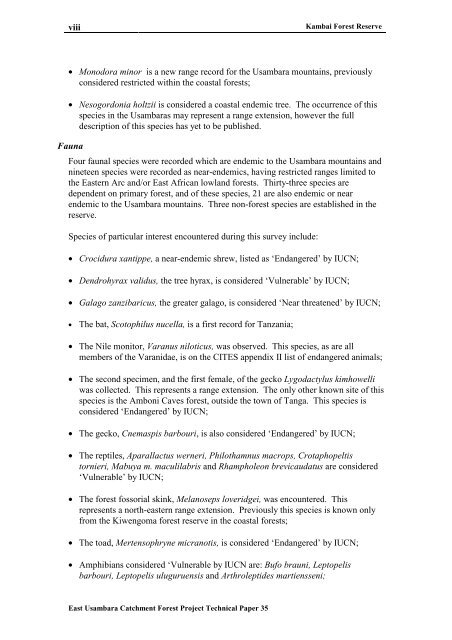East Usambara Catchment Forest Project Technical Paper 35 ...
East Usambara Catchment Forest Project Technical Paper 35 ...
East Usambara Catchment Forest Project Technical Paper 35 ...
Create successful ePaper yourself
Turn your PDF publications into a flip-book with our unique Google optimized e-Paper software.
viii<br />
Kambai <strong>Forest</strong> Reserve<br />
• Monodora minor is a new range record for the <strong>Usambara</strong> mountains, previously<br />
considered restricted within the coastal forests;<br />
• Nesogordonia holtzii is considered a coastal endemic tree. The occurrence of this<br />
species in the <strong>Usambara</strong>s may represent a range extension, however the full<br />
description of this species has yet to be published.<br />
Fauna<br />
Four faunal species were recorded which are endemic to the <strong>Usambara</strong> mountains and<br />
nineteen species were recorded as near-endemics, having restricted ranges limited to<br />
the <strong>East</strong>ern Arc and/or <strong>East</strong> African lowland forests. Thirty-three species are<br />
dependent on primary forest, and of these species, 21 are also endemic or near<br />
endemic to the <strong>Usambara</strong> mountains. Three non-forest species are established in the<br />
reserve.<br />
Species of particular interest encountered during this survey include:<br />
• Crocidura xantippe, a near-endemic shrew, listed as ‘Endangered’ by IUCN;<br />
• Dendrohyrax validus, the tree hyrax, is considered ‘Vulnerable’ by IUCN;<br />
• Galago zanzibaricus, the greater galago, is considered ‘Near threatened’ by IUCN;<br />
• The bat, Scotophilus nucella, is a first record for Tanzania;<br />
• The Nile monitor, Varanus niloticus, was observed. This species, as are all<br />
members of the Varanidae, is on the CITES appendix II list of endangered animals;<br />
• The second specimen, and the first female, of the gecko Lygodactylus kimhowelli<br />
was collected. This represents a range extension. The only other known site of this<br />
species is the Amboni Caves forest, outside the town of Tanga. This species is<br />
considered ‘Endangered’ by IUCN;<br />
• The gecko, Cnemaspis barbouri, is also considered ‘Endangered’ by IUCN;<br />
• The reptiles, Aparallactus werneri, Philothamnus macrops, Crotaphopeltis<br />
tornieri, Mabuya m. maculilabris and Rhampholeon brevicaudatus are considered<br />
‘Vulnerable’ by IUCN;<br />
• The forest fossorial skink, Melanoseps loveridgei, was encountered. This<br />
represents a north-eastern range extension. Previously this species is known only<br />
from the Kiwengoma forest reserve in the coastal forests;<br />
• The toad, Mertensophryne micranotis, is considered ‘Endangered’ by IUCN;<br />
• Amphibians considered ‘Vulnerable by IUCN are: Bufo brauni, Leptopelis<br />
barbouri, Leptopelis uluguruensis and Arthroleptides martiensseni;<br />
<strong>East</strong> <strong>Usambara</strong> <strong>Catchment</strong> <strong>Forest</strong> <strong>Project</strong> <strong>Technical</strong> <strong>Paper</strong> <strong>35</strong>
















